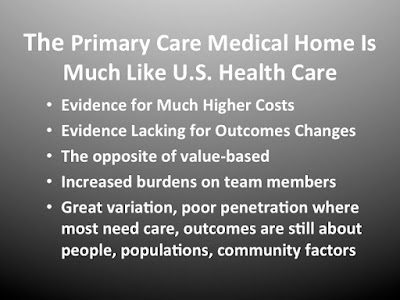Punishing Primary Care with Medical Homes

Context matters in health care. This is because outcomes are about the patient, community resources, social determinants, environments, situations, behaviors, housing, and other personal and community factors. Outcomes are predominantly not about clinical interventions. This is a very difficult to understand but most important concept. Clinical interventions are small change regarding health outcomes. The context for this blog response is a recent Commonwealth Review of PCMH. There were changes in a few outcomes, but overall there was little change. "PCMH initiatives were not associated with changes in the majority of outcomes studied, including primary care visits, emergency department visits, inpatient visits, and four quality measures." The article claims that context matters, and may explain the lack of outcomes for primary care medical home. High Cost for Little Change Via PCMH - the Opposite of Value Primary care medical home costs run about $8...